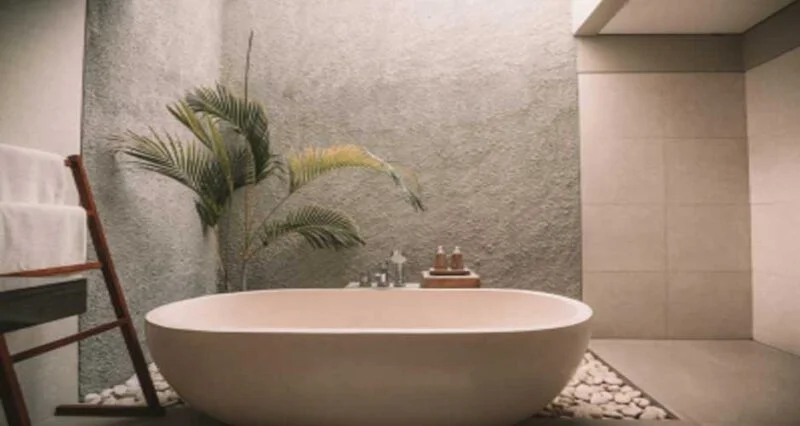
When designing a bath and shower area, it’s essential to balance aesthetic appeal with functional safety. Creating a space that is both beautiful and practical can enhance everyday routines and ensure that all users, regardless of age or mobility, can navigate comfortably and safely. This article provides detailed guidance on integrating style with safety features that cater to everyone’s needs. By focusing on key elements such as flooring, lighting, and accessibility, homeowners can achieve a bathroom that is not only a pleasure to use but also minimizes the risks of accidents.
1. Non-Slip Flooring
The foundation of a safe bathroom design is non-slip flooring. Materials like textured tiles, rubber flooring, or slip-resistant vinyl are excellent choices that prevent slips and falls, even when wet. These options come in various styles and colors, allowing you to maintain an elegant look without compromising on safety. In addition, proper installation and sealing can enhance the effectiveness of these flooring choices, ensuring long-lasting protection against accidents.
2. Handheld Showerheads
Handheld showerheads make any shower safer and easier to use. They let you point the water exactly where you need it, which means you don’t have to move around as much. This is really helpful for people who need to sit or stay in one place while they shower. These showerheads come in different styles and finishes, so they can make your bathroom look better while keeping you safe. However, it’s best not to install these by yourself. If you try to do it without the right skills, it could end up costing you time and money. Instead, look up bathroom remodeling near me online to find experts who can do the job right and maybe even improve your bathroom’s lighting.
3. Proper Lighting
Lighting in a bath and shower area is important not only for safety but also for creating a visually appealing space. Bright, clear lighting can prevent missteps and falls by illuminating slippery surfaces and any changes in floor level. Consider layering light with a combination of overhead lights and task lighting around mirrors and in the shower area. This approach not only enhances safety but also elevates the overall ambiance of the bathroom.
4. Accessible Shower Controls
Incorporating accessible shower controls enhances safety by allowing users to adjust water settings without stepping into wet areas. Positioning controls within easy reach from both inside and outside the shower can prevent uncomfortable stretching and reaching. Consider thermostatic controls which maintain water temperature and prevent scalding—a must-have feature in any modern bathroom. Consultation with a design expert can help integrate these elements seamlessly into your bathroom’s layout.
5. Built-in Seating
Built-in seating in a shower isn’t just a luxury—it’s a practical feature for a safe bathroom design. A built-in bench or a fold-down seat provides stability and comfort for everyone, especially those who may find standing for extended periods challenging. This feature can be designed to complement the rest of your bathroom’s style, using materials and colors that blend with your overall decor. It’s a simple addition that significantly enhances the functionality and safety of your shower space.
6. Wide Entryways
Designing wide entryways into your bath and shower area is essential for accessibility. This design feature ensures that individuals who use mobility aids, like walkers or wheelchairs, can move easily and safely into and out of the area. A wide, barrier-free entryway also reduces tripping hazards and supports a sleek, modern design aesthetic. Planning for a wider entrance may require structural adjustments, so it’s beneficial to consult with a professional during the planning phase.
7. Temperature Controls
Installing advanced temperature controls in your shower can significantly enhance both safety and comfort. Thermostatic valves prevent sudden temperature changes, protecting users from scalding—a common hazard in bathrooms. These controls allow you to set a precise temperature, which is maintained throughout the shower, regardless of other water usage in the home. This feature is especially beneficial in households with young children or elderly individuals, ensuring a safe bathing environment for all ages. Additionally, modern thermostatic controls come in various styles that can complement any bathroom design, marrying function with elegance.
8. Shatterproof Glass
Using shatterproof glass in shower enclosures is an excellent safety measure. This type of glass minimizes the risk of injury from broken glass, making it ideal for both family homes and high-traffic bathrooms. Shatterproof glass is designed to break into small, blunt pieces that are less likely to cause harm, providing peace of mind for all users. Beyond safety, shatterproof glass maintains a clean, sleek look that enhances the visual spaciousness of the bathroom, contributing to a design that feels both open and secure.
9. Ample Storage
Proper storage solutions in a bathroom can greatly reduce clutter, which in turn minimizes the risks of trips and falls caused by objects left on the floor. Designing sufficient storage allows for all toiletries, towels, and other bathroom essentials to be neatly stored and easily accessible. Consider incorporating built-in niches or cabinets within the shower area for practicality and aesthetics. These storage solutions can be tailored to match the bathroom’s design theme, ensuring functionality without compromising on style.
10. Anti-scald Faucet Devices
Installing anti-scald devices on faucets is an important safety measure for any bathroom. These devices automatically adjust the flow of hot water to prevent temperatures from reaching dangerous levels. They are particularly useful in homes with children or elderly individuals, providing an extra layer of protection against burns. Anti-scald devices are available in various designs that can seamlessly integrate into any bathroom’s existing fixtures, ensuring safety does not detract from the overall design.
11. Proper Ventilation
Adequate ventilation in the bath and shower area is essential for maintaining a safe and comfortable environment. Effective ventilation systems reduce humidity and moisture buildup, which can lead to slippery surfaces and the growth of mold and mildew. These conditions can compromise both health and the structural integrity of bathroom materials. Modern ventilation systems can be both powerful and unobtrusive, fitting neatly into a stylish bathroom design while promoting air quality and surface safety.
12. Barrier-Free Design
Adopting a barrier-free design in the shower area not only enhances safety by removing tripping hazards but also caters to the accessibility needs of all users. Zero-threshold showers are particularly useful for individuals with mobility issues as they allow for easy entry and exit. This design feature can be elegantly integrated into any modern bathroom, ensuring the space is both accessible and aesthetically pleasing. Opting for a barrier-free design also future-proofs your bathroom, making it adaptable to the changing needs of its users over time.
Conclusion
Designing a safe and stylish bath and shower area requires careful consideration of both functionality and aesthetic appeal. By integrating smart safety features such as non-slip surfaces, shatterproof materials, and adequate lighting with sophisticated design elements, you can create a space that not only looks great but also ensures the well-being of all who use it. The key is to view safety features as integral components of the bathroom’s design, allowing you to build a space that is both secure and inviting. This approach not only enhances the quality of daily life but also adds value to your home, proving that practicality and elegance can indeed go hand in hand.

